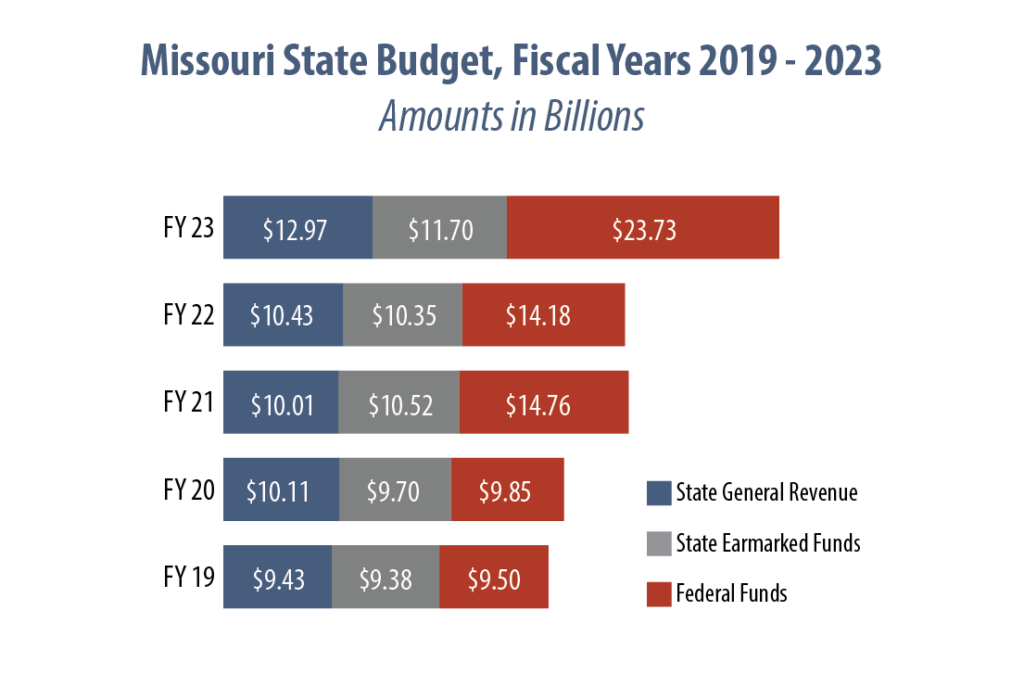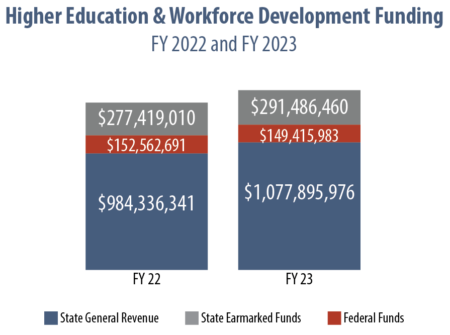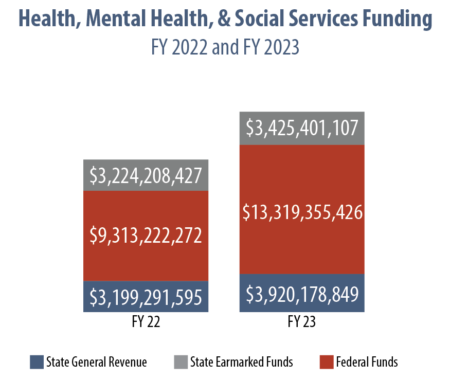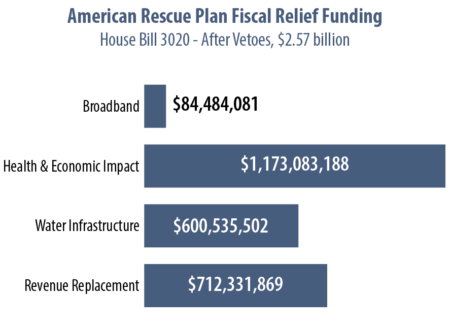The following was updated in July 2022 to include Governor Parson’s vetoes.
When developing Missouri’s annual budget, state lawmakers make decisions that affect the daily lives – and futures – of our kids, parents & grandparents, and neighbors. The importance of this responsibility was magnified in the 2022 legislative session, when members of the General Assembly had the extraordinary opportunity to allocate a substantial amount of federal funds sent to Missouri, in addition to traditional state revenue streams.
Lawmakers made significant investments in many much-needed services that all Missourians rely on, and it will continue to bolster Missouri’s economy over the coming years and support jobs in communities across the state.
This paper summarizes how, after gubernatorial vetoes, state resources for the budget year that began on July 1st will be invested – because appropriations decisions are not merely line items, or figures on a spreadsheet. Rather, each number in the state budget represents an investment in the wellbeing of Missourians, like:
- The child from a low wage family attending safe, quality early education, helping to ensure she enters school ready to learn, and
- The grandparent who can live independently at home because of home health services or the circuit breaker property tax credit, and
- The neighbor who is able to access the critical behavioral health services and medication that allows her to work & care for her family.
Overview
In May, Missouri legislators approved funding to provide critical public services during the budget year that began July 1, 2022 and ends on June 30, 2023 (fiscal year 2023). In June, Governor Parson vetoed about $644 million. The state budget now in effect for FY 2023 totals $48.399 billion.
This year’s budget is much larger than normal as a result of federal COVID response funds, which more than doubled federal investment in the state compared to a typical year. A large portion of that funding is earmarked for education, health care and child care, while $2.7 billion in funding is flexible “fiscal relief” for the state.

Sources of funding for the state budget include federal funding (both normal and extraordinary), state general revenue, and state earmarked dollars.
While the largest portion of total funding is dedicated to social services, health and mental health, the largest portion of state general revenue is dedicated to education.

Extraordinary Federal Funding
In addition to the types of federal dollars that Missouri receives every year, the FY 2023 state budget includes significant monies from federal COVID response packages. Federal aid comes from the following major pools of funds, most of which are dedicated to specific purposes:
- Child Care Stabilization & Discretionary Funding. The American Rescue Plan Act included $721 million for Missouri to stabilize the child care sector. The FY 2023 state budget authorized $450 million of that amount to support existing providers and increase access to quality care. The remainder of the funding will be appropriated in future budgets.
- Education Funding. Congress provided $4.5 billion to Missouri to support the K-12 and higher education response to COVID and to provide services to mitigate learning loss during the pandemic. Most of this funding was appropriated in previous budget bills, including the “emergency” supplemental spending bill state lawmakers approved earlier this year (House Bill 3014). The FY 2023 budget approves the use of the remaining education funding.
- Enhanced Federal Matching Funds for Medicaid. As in previous economic crises, Congress boosted the federal Medicaid matching rate to help offset the cost of increased enrollment and federal continuous coverage requirements tied to the federal public health emergency (PHE). The enhanced federal match began on January 1, 2020 and will continue until the end of the PHE. Over the three federal fiscal years for which the federal rate has been increased, Missouri is expected to receive an additional $2.9 billion in federal Medicaid dollars. According to the Kaiser Family Foundation, this amount is more than triple the additional state spending required due to increased enrollment.
- American Rescue Plan Coronavirus State Fiscal Recovery Funds. The American Rescue Plan Act provided Missouri with $2.7 billion in largely flexible fiscal relief funding to Missouri. The state has received half of that funding, with the other half expected in 2023. Lawmakers approved the use of most of these funds in a special appropriations bill (House Bill 3020).
- American Rescue Plan Medicaid Expansion Incentive. In addition to the enhanced federal Medicaid match, the American Rescue Plan included a financial incentive for states to expand Medicaid if they had not already done so. The timing of that legislation allowed Missouri to qualify for the incentive, which will provide an additional $1.15 billion in federal funds to support Missouri’s pre-expansion Medicaid program.
FY 2022 Supplemental Budget
In addition to the FY 2023 Budget, state lawmakers approved a $5.427 billion supplemental budget for the budget year that ended on June 30, 2022. The FY 2022 supplemental bill included several significant items:
- a portion of the federal COVID assistance for education;
- funding to support Medicaid expansion (that had been left out of the original FY 2022 budget); and
- funding to increase state employee salaries to a base of $15 per hour and to provide cost of living adjustments for all state employees.
These items were continued in the FY 2023 budget, which is described in more detail in the next section.

Education in the FY 2023 Budget
K-12 Education
Not counting the FY 2022 supplemental budget, total funding for the Department of Elementary and Secondary Education (DESE) increased from less than $7.5 billion in FY 2022 to $10.39 billion in FY 2023. The increase is primarily a result of federal COVID relief funding. The Department provides support for local schools to serve an estimated 917,000 students.

Major items in the DESE budget include:
- Full funding of the school “foundation formula,” which provides state funding support to local schools. The State Adequacy Target continues at $6,375 per student, where it has been since FY 2020.
- A substantial increase in funding for school transportation. Although the transportation funding entitlement is capped at 75% of eligible costs, the state provided just 32% of that cost in FY 2021.iv School transportation was allocated $328 million in FY 2023, up from $114 million in FY 2022. As a result, the state will fully fund its portion of student transportation for the first time since FY 2007.
- $21.8 million to increase the minimum teacher salary from $25,000 to $38,000. To receive this funding local school districts must fund 30% of the cost of salary increases.
- $25 million for the “Close the Gap” Grant Program, which will provide grants to families for educational expenses including tutoring, summer camps and afterschool programs with educational components, and other costs. Families with incomes up to 185% of the federal poverty level would be eligible for grants up to $1,500. DESE will administer the program.
- $450 million of the federal child care stabilization and discretionary funding.v States can use the funding to strengthen the child care industry and increase access to care for families, including increasing income eligibility and reducing costs for the child care subsidy, increasing child care provider rates to make them more adequate relative to the actual cost of care, and providing grants to providers to expand programs.
- $29 million for the Parents as Teachers home visitation program, a $6 million increase. Missouri’s Parents as Teachers (PAT) program has received international acclaim as a key strategy to prepare children to succeed in school. PAT provides 218,000 family home visits annually and provides developmental screenings to more than 100,000 kids each year.
- $18.4 million to support additional home visitation programs to families with children who are at risk of entering the child welfare system and through the Maternal, Infant & Early Childhood Home Visiting Program (MIECHV).
- $22 million for Afterschool Programs.
Higher Education
Not including the FY 2022 supplemental budget, total funding for Higher Education and Workforce Development increased by slightly more than $100 million, from $1.4 billion in FY 2022 to $1.5 billion in FY 2023.

Significant items in the Higher Education budget include:
- $174.8 million for Missouri’s community colleges, which served 46,000 students in fall 2020. The funding represents an increase of $21 million over the FY 2022 appropriation.
- $8.5 million for the State Technical College of Missouri, an increase of $440,000. The College serves about 1,800 students per year.
- $855.6 million to support Missouri’s four-year colleges and universities, which serve 105,000 students annually.
In addition to appropriations, lawmakers added language to the budget bill prohibiting colleges from providing scholarships or in-state tuition rates to undocumented students.
Health, Mental Health, Senior Services and Social Services in the FY 2023 Budget
Not counting the FY 2022 supplemental budget, total funding for the Departments of Health & Senior Services, Mental Health, and Social Services increased to $20.67 billion from $15.74 billion, largely due to federal COVID funds.

Significant items in the Health, Mental Health, Senior Services and Social Services budgets include:
- Full funding of $2.5 billion to support Medicaid expansion, which will provide health care coverage to an estimated 275,000 Missourians. Lawmakers used state funding freed up by the federal Medicaid expansion incentive to fund the state match.
- $700 million to support Consumer-Directed Services as well as $700 million for Home- and Community-Based Services.
- $34 million to support redeterminations of Medicaid eligibility when the public health emergency ends. The funding supports staffing, technology and third-party verification services.
- $2 million to acute care hospitals to assist with Medicaid enrollment and $2.5 million to support the Community Health Worker Initiative.
- $10 million to connect Medicaid providers with Electronic Health Records and $50 million to transfer existing Health Information Exchange into the Health Data Utility, which is intended to improve access to health data and care delivery.
- $23 million to support new Suicide Hotline and Mobile Crisis Response Teams through the Department of Mental Health (DMH). The funding is included in several lines in the DMH budget (House Bill 3010) and in the ARPA spending bill (House Bill 3020).
- $91 million to support Area Agencies on Aging, including funds to expand infrastructure for meal programs and to provide home and community services.
- $154 million in dedicated ARPA funding to support the public health workforce and programs.
American Rescue Plan Fiscal Relief in the FY 2023 Budget
In addition to the regular budget bills, lawmakers approved House Bill 3020, which lays out Missouri’s plan for spending the bulk of the $2.68 billion in state aid provided through the federal American Rescue Plan (ARPA). Missouri policymakers must obligate these funds by the end of 2024 and spend them by the end of 2026. After the Governor’s vetoes, House Bill 3020 appropriates just over $2.57 billion of this aid.
The federal government’s response to COVID – including financial support for state services and direct assistance to individuals, families, businesses, and nonprofits – has bolstered Missouri’s economy and state budget through what otherwise would have been an economic crisis. As a result, Missouri does not need to use ARPA funding to fill budget holes and simply maintain basic services. Rather, ARPA resources provide a critical opportunity for Missouri to make transformative investments that can address the health and economic consequences of the pandemic AND build toward a better and more equitable future for all Missourians.

The budget approved by lawmakers takes steps toward that end, making key investments to improve health and economic outcomes for all Missourians, including:
- Expansion of broadband and improved IT infrastructure, which will increase access to education, work, telehealth, and state safety net services when needed.
- Workforce development, training initiatives, and improvements in higher education infrastructure to enhance learning.
- Funding for the Department of Health and Senior Services to construct a state-of-the-art laboratory to support public health, agriculture and animal health, and environmental quality.
- Grants for local community development projects, which could allow communities to develop much needed affordable workforce housing.
- Grants to support capital improvements at Missouri’s community health and behavioral health clinics.
- Grants to groups like nonprofits, small businesses, and child welfare & arts organizations.
In addition to ARPA funding, House Bill 3020 also appropriates $20 million in state conservation funds and $197 million in other federal funds. Post-veto, the bill totals $2.787 billion.
Conclusion
State legislators will have the opportunity to override gubernatorial line-item vetoes during the veto session scheduled to begin on Wednesday, September 14, 2022.

